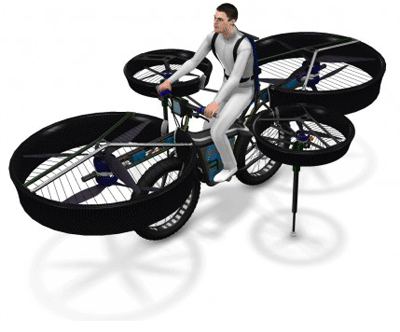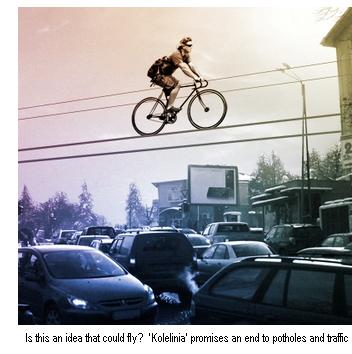
 A cycle lane that is never blocked by parked cars may be no more than a dream for many British cyclists, but such infrastructure may be rendered obsolete if a radical new design for a flying bicycle ever gets off the ground.
A cycle lane that is never blocked by parked cars may be no more than a dream for many British cyclists, but such infrastructure may be rendered obsolete if a radical new design for a flying bicycle ever gets off the ground.
The FBike design does not appear entirely well-suited to manoeuvring on city streets; at two-and-a-half metres wide the bike would have difficulty negotiating city centres. However, the Czech companies behind the project claim that it will be able to take to the skies for up to five minutes before its electric motors need recharging.
A spokesperson for the Environmental Transport Association (ETA) said: “I would hope the bike would be less unwieldy in the air than it looks like it would be to ride on the ground.”
| FBike specifications | |
|---|---|
| Watch the F-bike design on YouTube | |
| Power | 50 kW |
| Drive | 4× main motor 10 kW |
| Energy | set of Li-Pol accumulators with total capacity 50 Ah |
| Dimensions | approx. 3500 mm (length) × 2500 mm (width) × 1200 mm (height) |
| Weight | 85 kg without a pilot |
| Maximum laden weight | 170 kg |
| Flight time | 3 – 5 minutes |
Protect your bicycle from thieves
Cycle insurance from the ETA does not (currently) cover flying bicycles, but is comprehensive in other respects. As well as covering against theft and vandalism, the policy allows you to claim for accidental damage such as that caused by a pothole. It also includes third party insurance, personal accident cover and if you breakdown, a van will come out and recover you and your bike.
Other flights of fancy…

 Kolelinia – a contraction of the Bulgarian words for ‘bike and ‘line’ – is a design that allows cyclists with nerves of steel to soar up to 4.5 metres above motorised traffic and potholes by taking to a network of wires.
Kolelinia – a contraction of the Bulgarian words for ‘bike and ‘line’ – is a design that allows cyclists with nerves of steel to soar up to 4.5 metres above motorised traffic and potholes by taking to a network of wires.
The bicycle travels in a cupped track and is temporarily attached via its handlebar to a steel wire for stability. The cyclsit dons a safety harness and then pedals as normal.
Kolelinia is designed to separate cyclists and motorised traffic in areas where they intersect and to generate additional space where there is no room for traditional cycle lanes. It is likely that its first application will be at a tourist site where it will be marketed as a ‘high adrenaline’ experience.
The idea has already won an international architectural competition. For a more detailed description of the idea visit the Kolelinia website.
0 Comments View now